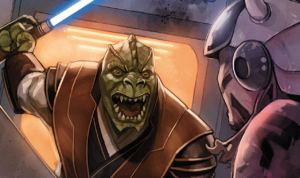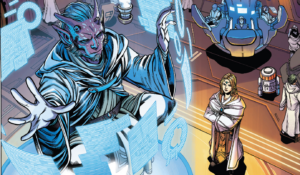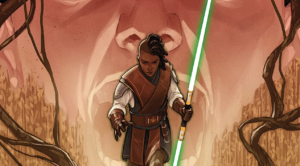For your reading pleasure, please enjoy this exclusive preview from Issue 43 of Backstory. If you enjoy what you read below – we hope you’ll join us to read the rest of the issue by buying Issue 43 as a single issue or subscribing to Backstory Magazine!
Cavan Scott and Daniel José Older help usher in an entire new era of Star Wars storytelling with two new comic-book series.
By Danny Munso
What is Star Wars without the Skywalkers? This question is about to be answered by Lucasfilm, as the studio behind the biggest and most important film franchise in cinema history begins a period of great transition. With the nine-film Skywalker saga officially closed in 2019, Lucasfilm is heading off in new directions. Not only has it pivoted to streaming as its main distribution, where the company is set to release no fewer than 10 projects on Disney+ over the next four years, as the Skywalkers officially cede the spotlight to other characters, but one of its biggest swings is one that won’t be happening onscreen: Star Wars: The High Republic.
Shepherded by Lucasfilm Publishing creative director Michael Siglain, this new era of storytelling is set 200 years before the Skywalker saga begins and represents a time period in the galaxy that has to this point gone completely unexplored in any medium. A multiyear multiplatform initiative set to roll out in novels, YA books, middle-grade texts, graphic novels, a VR story and much more, The High Republic will incorporate 10 types of stories in its initial wave alone between January and July 2021. The creative minds selected by Siglain to usher in this new age are a who’s-who of prominent Star Wars authors from the past half decade: Claudia Gray, Justina Ireland, Daniel José Older, Cavan Scott and Charles Soule.
Comics are a major area of focus for The High Republic and here takes the form of two separate series: Scott’s Star Wars: The High Republic for Marvel and Older’s all-ages IDW series Star Wars: The High Republic Adventures. Though IDW is Lucasfilm’s preferred label for its kid-centric titles, including the popular Star Wars Adventures, this Older series is not just for the young ones. “I love the work Star Wars Adventures has been doing,” he says. “I think it’s really dope, but it is very specifically geared toward young people. Mike [Siglain] and I wanted this story to be young people accessible and old people accessible because that’s what Star Wars always is. For the most part, Star Wars is for all ages, and that’s why we love it.”

In the beginning, Siglain hatched a concept for this type of multiplatform initiative but didn’t know what the specific story would be. To flesh it out, he gathered the five authors along with members of Lucasfilm’s Story Group, concept artists and others for a retreat at Skywalker Ranch, where ideas were thrown around. Once The High Republic was decided on as the preferred direction, another retreat took place where specific stories and characters began to take shape. The authors mostly came up with their own stories they would be penning, but some cross-pollination was expected and encouraged. “It’s very collaborative, but it’s also very individual in different ways,” Older says. “It’s very much a combination of both. There are a lot of hands on the stories, but even though we always don’t agree, we trust one another. We’ve all written for Star Wars before so we’re all tuned into the same thing.” The result is a wealth of stories that stand alone yet have an unprecedented amount of crossover. For his Marvel series, Scott had the start of the idea for the Drengir, sentient plant beings with a strong connection to the Dark Side of the Force, and yet the Drengir are also central figures in Gray’s YA novel Into the Dark. Scott’s series also sees Jedi Master Sskeer working through a dark period in his life after losing close friend Jora Malli, an event that occurs near the end of Soule’s Light of the Jedi novel, the launch point for the entire series. “I always want the Easter eggs to feel like a reward and not a punishment,” Scott says. “If someone is reading everything, they’ll get a buzz out of certain connections. But if they’re not, it’s not going to affect their enjoyment. There are always challenges when you’re working with a group of writers, but I thrive on it. The ideas you come up with together are always better than the ones you have on your own.”
Though there are a range of crucial characters in each title, the central figures in the High Republic offerings are clearly the Jedi. And these aren’t the jaded Jedi we meet in the prequel trilogy, who make critical mistakes that directly lead to the galaxy’s downfall to the hands of the Empire. These Jedi preside over a time of peace and prosperity, where new discoveries about the universe and the Force are encouraged and explored. Of course, this is Star Wars, so something absolutely goes wrong. There’s a galactic disaster the Jedi must navigate as well as the arrival the Nihil, a group of deadly pirates who begin to wreak havoc on the galaxy. For the authors, exploring the various types of Jedi has been one of the clear highlights of the experience thus far. “This is a different time,” Older says. “This is a time of peace, and it’s a renaissance. You can already see from the books to the comics, there is a complexity and diversity to how different Jedi have different understandings of the Force. We’re all fans first, too, so it’s equally fascinating for us to write Jedi like this.”

The wide canvas also gives the writers room to explore emotional facets of the Jedi that we have never seen in a Star Wars title. In Scott’s Marvel series, his main character is Keeve Trennis, a young Padawan who in the first issue passes her trials and becomes a Jedi knight. Keeve is highly skilled and brave, but because Scott shows us Keeve’s internal dialogue on the page, we also know she is filled with self-doubt about whether she’s worthy enough to have this lofty title and responsibility. “Our Jedi are supposed to be when the Order and the Republic are at the height, but that doesn’t mean they’re all perfect,” Scott says. “They shouldn’t be perfect because perfect characters are dull. I wanted to tell a story about a Jedi who struggles. She doesn’t struggle to be a Jedi, because she’s a very good Jedi. It’s deeper. She struggles to be herself within the Jedi. She doesn’t see what other people see in her. Just because she has been made a Jedi, it doesn’t necessarily mean she feels ready. Just because Jedi aren’t supposed to feel apprehension or anxiety or fear doesn’t mean they don’t. These characters still have to go through basic human emotion, otherwise what they do won’t seem incredible. It will seem too easy. I never wanted a character where being a Jedi meant waving your finger and someone flies across the room. There has to be an internal process for that. When you have that responsibility and you have this power and you have the entire galaxy looking at you, what does that feel like when you think you shouldn’t be there?”
It was easy for Scott to channel those feelings into Keeve because what she’s feeling is something he confesses to dealing with while penning Star Wars. “I deal with imposter syndrome every day, especially working on something like this. I’ve had a lifetime of reading Star Wars and Marvel comics, and I have a sense of, What have I done that I’m allowed to be here? I felt that when we were sitting in Skywalker Ranch pitching the stories. What am I doing at this table? Rationally I knew. I had been working on Star Wars for a while. They trusted me and thought I had things to add to the story. But I still struggled, and I thought it would be interesting to see a Jedi in that situation. So that’s completely me tapping into my own worries.”
The first issue of Older’s series introduces us to its dual young protagonists: Padawan Lula Talisola, who is training under Master Yoda — the only legacy Star Wars character to appear in The High Republic — and a Force-sensitive girl named Zeen Mrala, who has grown up in a culture where using the Force is forbidden. “Since I knew it would be for all ages, I really wanted the young people to be the focus of the story,” Older says. “I went with a group of Padawans traveling around the galaxy with Master Yoda. They’re supposed to be learning cool lessons about the Force, but the Nihil get in the way and immediately have life-or-death situations on their hands.” Zeen’s arc through the first couple issues lends a fascinating element to the story. The treatment she receives is a window into the differences between the Jedi of this era and the ones we know from George Lucas’ films. In the prequel trilogy, after Anakin Skywalker is discovered to be Force sensitive later in life than most Jedi, he is kept at arm’s length by the Jedi Council. Though Obi-Wan eventually gets the Council to change its mind, that initial rejection is the first seed planted in Anakin that will eventually lead him down the path to becoming Darth Vader.
When Zeen’s power is discovered in the first issue, she is embraced by Lula, Yoda and the others immediately. It’s also impossible to miss the metaphor of Zeen being asked to repress a large part of who she is because others deem it unnatural. Older is clear that he wasn’t writing toward a specific prejudice, but he does want people to make that connection. “I think metaphors work better when things are really open,” he says. “A lot of people are going to be looking at it—they already are, actually—saying, ‘That was true for me.’ That’s what makes it work. There are forms of repression across the board in all societies. I also think in general people are often intimidated by young people who have power, whether it’s artistic power, intellectual power or any kind of power they’re not supposed to have. That makes older people uncomfortable. We see situations where people are actively trying to suppress a young person’s power, which is the worst thing you can do. It usually backfires.”

Older was thrilled to write a younger version of Yoda and a different one than we know from the films. “We’ve seen Yoda reluctantly fight and we’ve seen the wise-old-man version of him, but we really haven’t seen him like this,” says the scribe. “He’s a go-getter. He’s jumping into fights and has a wry sense of humor.” Though Older’s series deals with extremely serious life-or-death scenarios, it is also quite funny. Take the breakout Jedi character Torban Buck, better known by his self-appointed nickname, Buckets of Blood. The humorous explanation is that Torban is a healer who would prefer not to fight. The nickname comes from Older’s real-life: He was a paramedic before becoming a writer and would often hear colleagues tell tales of an older paramedic who called himself that. “I found it to be such an interesting and complicated personality trait to be both extremely heavy metal and gory but also very much a gentle, healing person. That name always stood out to me, and as a writer you just file stuff away that’s really cool. And that’s always been in the filing cabinet of my brain.”
Both Scott and Older have insane schedules that would nevertheless be the envy of many aspiring authors. Older just released the acclaimed YA novel Flood City and is prepping his next big original release, Ballad & Dagger, set for 2022 release on Rick Riordan Presents, an imprint from the popular Percy Jackson author. Scott has multiple comic-book series in print or in development at the moment, including his incredible creator-owned Shadow Service as well as the fifth book in his ongoing Warhammer Adventures middle-grade novels. But they’re also in the midst of crafting tons and tons of Star Wars. On June 29, both authors will have books released: Scott’s The Rising Storm and Older’s Race to Crashpoint Tower. In true High Republic fashion, the stories intersect and feature characters from previous novels written by the other three writers. And that barely scratches the surface of the Star Wars on the way from both, including the continuation of both comic series. “We have this big overarching document which looks a little like a murder investigation,” Scott laughs. “There are lines going everywhere, but that’s the joy of the process.” Though it’s early in the grand scheme, this much is clear: Longtime Star Wars fans who have longed for a type of story that branches out but still maintains the DNA of Lucas’ work are having as much fun reading The High Republic as its authors are while writing it.
If you like what you read, our current issue has a longer version of this piece that includes Cavan Scott and Daniel José Older detailing their issue-by-issue writing process.
Now more than ever, your support is crucial so please consider subscribing to Backstory!
You can also use coupon code: SAVE5 to take $5 off your subscription!
For more info about all the other amazing articles in our new issue, view our Table of Contents.